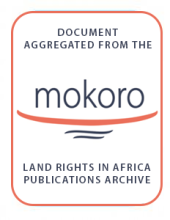Land Library Search
Through our robust search engine, you can search for any item of the over 73,000 highly curated resources in the Land Library.
If you would like to find an overview of what is possible, feel free to peruse the Search Guide.
/ library resources
Showing items 1 through 9 of 22.The purpose of the present Law is to safeguard the public interest on the occasion of the transfer of land or parts thereof, taking into account the need to comply with the principles of a sustainable protection of the environment, nature and landscape.
Articles in this edition develop several areas and introduce specific experiences relating to land reform. The main thread running through the articles is that of change; how we can help to understand what change means and how it can be managed.
The various legal, political, economic and social perspectives that have influenced the land reform discourse in Kenya are examined.
"The hour of capitalism's greatest triumph," writes Hernando de Soto, "is, in the eyes of four-fifths of humanity, its hour of crisis." In The Mystery of Capital, the world-famous Peruvian economist takes up the question that, more than any other, is central to one of the most crucial problems th
Summarises the 12 presentations made at the workshop, 8 of which concerned Mozambique, the remainder Sao Tome & Principe, Angola, Guinea Bissau and Cabo Verde.
The analysis of `ambiguous lands' and the people who inhabit them is most revealing for understanding environmental deterioration in Thailand. `Ambiguous lands' are those which are legally owned by the state, but are used and cultivated by local people.
Over the last decade, forests have played an important role in the transition from war to peace in Cambodia. Forest exploitation financed the continuation of war beyond the Cold War and regional dynamics, yet it also stimulated co-operation between conflicting parties.
The constitution was approved by 86.53% of voters in a national referendum.
Basée sur l’ordonnance n° 2000-914 du 18 septembre 2000 modifiée par l'ordonnance n° 2012-6 du 5 janvier 2012, la partie législative du Code de l'environnement français comprend sept (7) livres, entre autres, les dispositions communes (Livre I); les milieux physiques (Livre II); les espaces natur






